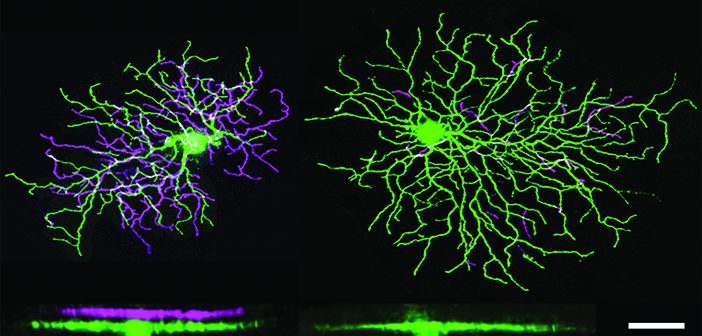Retinal cells go with the flow to assess the body’s motion through space.
Think of the way that a long, flat highway seems to widen out around you from a single point on the horizon, while in the rear-view mirror everything narrows again to one point. Or when a spaceship in a movie accelerates to warp speed, the illusion is conveyed by the stars turning into streaks that zip radially outward off the screen.
That’s how a study published in Nature in June says specialized retinal cells discern motion through the world—by sensing that same radiating flow.
The finding is part of a broader discovery, made in mouse retinas, that may help explain how mammals stabilize their vision and keep their balance as they move, says senior author David Berson, PhD ’75, chair of Brown’s Department of Neuroscience.
To sense how it’s moving in space, the brain relies on the motion-sensing vestibular system in the ears, and vision— specifically, how the image of the world is moving across the retina. The brain integrates information from these two systems, or uses one if the other isn’t available—in the dark, for example, or when motion is seen but not felt, as in an airplane at constant cruising speed.
“Good cameras have gizmos that stabilize images,” says Berson, the Sidney A. Fox and Dorothea Doctors Fox Professor of Ophthalmology and Visual Science. “That’s just what the retinal motion and vestibular systems do for our own eyes.”
From observations of thousands of retinal neurons led by Berson and lead author Shai Sabbah, PhD, a postdoctoral fellow in Berson’s lab, the research team found that direction-selective ganglion cells (DSGCs) are activated when they sense their particular component of the radial optical flow through a mouse’s vision. Arranged in ensembles on the retina, they collectively recognize the radiating optical flow resulting from four distinct motions: the mouse advancing, retreating, rising, or falling.
The reports from each ensemble, as well as from those in the other eye, provide enough visual information to represent any sort of motion through space. Sensing rotation is crucial for image stabilization, Berson says, because that’s how the eyes can stay locked on something even while the head is turning.
“One of the biggest mysteries that is revealed by our findings is that a motor system that will generate a rotation of the eye in service of image stabilization is ultimately driven by a class of retinal cells organized around the patterns of motion produced on the retina when the animal translates through space,” Berson says. “We don’t fully understand that yet.”
Notably, mice differ from people in this context because their eyes are on the sides of their head. Berson acknowledges no one has yet confirmed that humans or other primate eyes have DSGCs, but he strongly suspects they do.
“The function of image stabilization works in us very much the same way that it works not only in mice, but also in frogs and turtles and birds and flies,” he says. “This is a highly adaptive function that must have evolved early and has been retained. Despite all the ways animals move—swimming, flying, walking—image stabilization turns out to be very valuable.”
Read the full story here.




